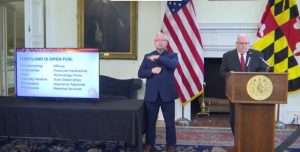
OCEAN CITY — As expected, Gov. Larry Hogan late Wednesday announced the state was prepared to enter stage two of his phased recovery plan, but unexpected was his continued reluctance to ease the struggles of the restaurant and hospitality industries.
Hogan announced on Wednesday stage two of his Maryland Strong: Roadmap to Recovery would take effect at 5 p.m. on Friday. Stage two of the recovery plan includes, among other things, the reopening of a wide array of businesses, religious facilities, retail establishments and certain personal services such as beauty salons, barber shops and nail salons.
What the governor’s stage two recovery plan does not include, however, much to the chagrin of the local hospitality industry, is the opening of indoor seating at restaurants and bars. The presumption all week was that Hogan would announce stage two and that came true on Wednesday afternoon. The other presumption was that stage two would include some easing of the restrictions on indoor seating at restaurants, bars and food service establishments.
That announcement never came on Wednesday. In fact, Hogan never mentioned the word “restaurant” at any point during his roughly 40-minute press conference, nor was he even asked about what stage two meant for the hospitality industry during the ensuing question-and-answer period.
The glaring omission left many in the resort hospitality industry shaking their heads and attempting to figure out what it all means for them. The short answer is it will be business as usual, or unusual, for most establishments that have steadily evolved from carryout and delivery only for several months to existing or modified outdoor seating only, which began in earnest last weekend for many.
While the governor did not mention restaurants or indoor and outdoor seating during his press conference, language in his official executive order clearly spells out there are no significant changes for the hospitality or amusement industries. The full executive order is available here.
“Restaurants, bars and other similar establishments that sell food or beverages for consumption on-premises in Maryland and social and fraternal clubs with dining facilities may, to the extent by applicable law serve food and beverages for consumption in outdoor seating areas; sell food and beverages that are promptly taken from the premises, for example on a carryout or drive-through basis; or deliver food and beverages to customers off the premises.”
Many resort business owners have been waiting for the governor to ease restrictions on certain amusements including, for example, amusement parks, miniature golf courses, go-kart tracks and arcades, all of which are staples in the local summertime tourism economy.
While he didn’t ease those restrictions in his executive order on Wednesday, he at least mentioned them as a possibility in the next segment of the recovery plan.
“Looking ahead, the next step will be considering the reopening of some outdoor activities and amusements,” he said. “That could coincide with the end of the school year.”
Shortly after the press conference, the Ocean City Hotel-Motel-Restaurant Association (OCHMRA) messaged its membership and implored the governor to ease the restrictions on the hospitality industry.
“What a disappointment to not even acknowledge tourism or the restaurant industry,” the statement reads. “Governor Hogan, restaurants and tourism are economic engines of Maryland, not to mention our only job base. Our business community hangs on a thread weekly for the slow trickle of information, or lack thereof. It is salt in the wound. Visitors are going to Delaware and Virginia and tax dollars are gone.”
The Greater Ocean City Chamber of Commerce issued an email to its membership, saying, “you may have seen, the Governor announced that as of Friday, June 5th at 5pm, we will move into Stage Two of the Roadmap to Recovery. However, unfortunately, the Executive Order does not allow for indoor dining or attractions to open at this time.”
So, in a broad sense what does stage two mean for the state and local economy? It means a somewhat return to normal for most businesses including retail establishments large and small, religious facilities, manufacturing, offices including real estate offices, travel agencies and the like.
Stage two also continues many of the current restrictions and Centers for Disease Control (CDC) guidelines including physical distancing, the wearing of masks and, in some cases, capacity limitations. For example, retail establishments and religious institutions are limited to 50% of their rated capacity.
The conventional thinking all week was that stage two would also include indoor seating at restaurants with a similar capacity limitation. For the record, neighboring Delaware this week entered stage one of its recovery plan including indoor seating at restaurants with a 30% capacity limitation, which will increase to 60% on June 15.
Nonetheless, Hogan implementation of stage two continues to inch Maryland along in its phased recovery plan. The announcement comes as the state continues to see certain key metrics such as the number of hospitalizations, the number of intensive care unit (ICU) admissions and the number of deaths in Maryland. Hogan praised Marylanders for their resilience during the crisis, praise that likely fell on deaf ears for many in the hospitality industry.
“Moving to stage two is an important step for our state after what has been a very difficult period,” he said. “The people of our great state of endured so many significant personal, medical and economic challenges, but in the face of the most daunting challenge in our lifetime, the people of Maryland have been resilient, they’ve never lost hope and they are showing what it truly means to by Maryland strong.”

